Letter of Intent to Sue
[Your Name]
[Your Address]
[City, State, Zip Code]
[Your Email Address]
[Your Phone Number]
[Date]
[Recipient's Name]
[Recipient's Address]
[City, State, Zip Code]
Dear [Recipient's Name],
This letter serves as a formal Letter of Intent to Sue under the laws of the state of [State]. I am notifying you of my intention to pursue legal action regarding the matter described below.
Here are the key details of my complaint:
- Nature of the Complaint: [Briefly describe the issue or incident that led to your complaint]
- Date of Incident: [Date]
- Involved Parties: [List any other individuals or organizations involved]
I have made attempts to resolve this matter amicably, including:
- [List any attempts at resolution, such as phone calls, emails, or meetings]
Unfortunately, these attempts have not produced a satisfactory resolution. Therefore, if this situation is not resolved by [specific time frame, e.g., "30 days from the date of this letter"], I will proceed with filing a lawsuit. Please take this letter seriously as I would prefer to resolve matters without extensive legal proceedings.
I encourage you to reach out to me at your earliest convenience. I believe that we can find a satisfactory resolution without the need for court intervention.
Thank you for your attention to this matter. I look forward to your prompt response.
Sincerely,
[Your Name]
